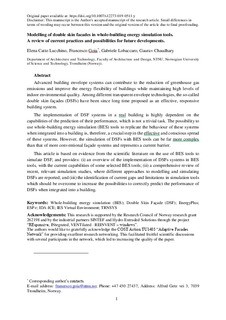| dc.contributor.author | Catto Lucchino, Elena | |
| dc.contributor.author | Goia, Francesco | |
| dc.contributor.author | Lobaccaro, Gabriele | |
| dc.contributor.author | Chaudhary, Gaurav | |
| dc.date.accessioned | 2019-04-10T05:55:50Z | |
| dc.date.available | 2019-04-10T05:55:50Z | |
| dc.date.created | 2019-02-07T07:15:49Z | |
| dc.date.issued | 2019 | |
| dc.identifier.citation | Building Simulation. 2019, 12 (1), 3-27. | nb_NO |
| dc.identifier.issn | 1996-3599 | |
| dc.identifier.uri | http://hdl.handle.net/11250/2593913 | |
| dc.description.abstract | Advanced building envelope systems can contribute to the reduction of greenhouse gas emissions and improve the energy flexibility of buildings while maintaining high levels of indoor environmental quality. Among different transparent envelope technologies, the so-called double skin facades (DSFs) have been since long time proposed as an effective, responsive building system. The implementation of DSF systems in a real building is highly dependent on the capabilities of the prediction of their performance, which is not a trivial task. The possibility to use whole-building energy simulation (BES) tools to replicate the behaviour of these systems when integrated into a building is, therefore, a crucial step in the effective and conscious spread of these systems. However, the simulation of DSFs with BES tools can be far more complex than that of more conventional facade systems and represents a current barrier. This article is based on evidence from the scientific literature on the use of BES tools to simulate DSF, and provides: (i) an overview of the implementation of DSFs systems in BES tools, with the current capabilities of some selected BES tools; (ii) a comprehensive review of recent, relevant simulation studies, where different approaches to modelling and simulating DSFs are reported; and (iii) the identification of current gaps and limitations in simulation tools which should be overcome to increase the possibilities to correctly predict the performance of DSFs when integrated into a building. | nb_NO |
| dc.language.iso | eng | nb_NO |
| dc.publisher | Tsinghua University Press and Springer-Verlag | nb_NO |
| dc.title | Modelling of double skin facades in whole-building energy simulation tools. A review of current practices and possibilities for future developments. | nb_NO |
| dc.type | Journal article | nb_NO |
| dc.type | Peer reviewed | nb_NO |
| dc.description.version | acceptedVersion | nb_NO |
| dc.source.pagenumber | 3-27 | nb_NO |
| dc.source.volume | 12 | nb_NO |
| dc.source.journal | Building Simulation | nb_NO |
| dc.source.issue | 1 | nb_NO |
| dc.identifier.doi | https://doi.org/10.1007/s12273-019-0511-y | |
| dc.identifier.cristin | 1674332 | |
| dc.relation.project | Norges forskningsråd: 262198 | nb_NO |
| dc.description.localcode | This is a post-peer-review, pre-copyedit version of an article published in Building Simulation. Locked until 23 January 2020 due to copyright restrictions. The final authenticated version is available online at: https://doi.org/10.1007/s12273-019-0511-y | nb_NO |
| cristin.unitcode | 194,61,55,0 | |
| cristin.unitname | Institutt for arkitektur og teknologi | |
| cristin.ispublished | true | |
| cristin.fulltext | postprint | |
| cristin.qualitycode | 1 | |
